--
The Desert Steamers
By Richard E. LingenfelterThe silver mining booms of the 1870's brought to the desert country of eastern California a curious maritime history, a history that embraced a decade of steamboating on the saline waters that were once Owens Lake. The decade opened at the shore of Owens Lake on a sultry Fourth of July morning in 1872, with the christening of the first of the desert steamers - the screw Bessie Brady. Her champions and later her eulogizers wished many laurels for the little steamer, proudly proclaiming her to be "the Pioneer inland steamer of the Pacific Coast -being the first to run on interior waters for strictly commercial purposes." This unfortunately was not true. Even excepting the Great Salt Lake whose first steamer, the Kate Connor, was launched only four years earlier, the Pacific Coast already had a robust legacy of inland steamboating, commencing with the maiden voyage of the lumber steamer, Gov. Blaisdel, upon the pristine waters of Lake Tahoe in 1864 and spreading to such an unlikely spot as the man-made reservoir of Meadow Lake in 1866, and to nearby Donner Lake a few years later.
 Owens Lake - pre 1913
Owens Lake - pre 1913Nonetheless, the Bessie Brady was a unique pioneer, the first of a handful of curious craft which in the years to follow were destined to chum a foamy wake on all of the desert lakes of eastern California and western Nevada - from Owens. Mono and Walker Lakes on the south to Klamath, Pyramid and Honey Lakes on the north.
The idea of putting a steamer on Owens Lake was first conceived by James Brady, superintendent of the Owens Lake Silver-Lead Company's smelting furnaces at Swansea on the eastern shore of the lake. Brady was a newcomer to the valley and he had quickly earned a reputation among the old timers as being somewhat of a dandy. His first official act as superintendent was to hire a coachman with a carriage-and-four for the sole purpose of driving him about the countryside. So afterward he built a large and commodious adobe house for himself near the lake shore - complete in every detail including a cool "wine room" stocked with hogsheads of Basses" ale and bitter beer. Such elegance, mostly at company expense, rankled many of the practical miners and when he decided to build a $10,000 steamboat, supported by company funds, there was strong speculation that it was solely intended to be Brady's private yacht. Nonetheless, the introduction of a steamer was to prove a sound financial investment for several years, although Brady sold out before he had a full opportunity to enjoy its success.
The keel of the Bessie Brady was apparently laid in late February or early March by William Tiernan on the bank of the Owens River, a few miles above the lake. The hull was finally completed in late May, after many trying delays, the greater part of which resulted from the terrible havoc wrought by the great Owens Valley earthquake on March 26. The craft was then floated down to the lake and moored at the new wharf at Swansea. There the boiler and engines were mounted and on June 27 the Bessie Brady made her maiden voyage across the lake. On this trip she carried 700 bars or about thirty ton of silver bullion from the Swansea furnaces to the waiting wagon teams at the foot of the lake. The following week she was christened and served as the center of attraction at the Fourth of July celebration. She still lacked deck houses and other minor work, however, and it was not until the end of July that she was completely fitted and ready for service.
While the hull was being built on the river, the Owens Lake SilverLead Company started its wharf at Swansea and land speculation began at the other would-be lake ports. D.H. Ferguson, the co-projector of the steamer, staked out a plot of land at the northwest comer of the take where he planned to build a wharf to carry all of the trans-shipping north into Owens Valley. Even before the wharf was built he christened the site Ferguson's Landing. John Baptise Daneri, a native of Sardinia and a successful merchant at Lone Pine, was the first outsider to take advantage of the new project. In June he commenced building a large warehouse and store at the southwest shore of the lake at the head of the road to Los Angeles. Before the end of the month the first bullion was unloaded at his landing and it was soon conceded that this was to be the major port on the lake - controlling as it did all bullion shipments out of the valley to the south and nearly all in-bound freight shipments. Despite its increasing importance this port was without a name for nearly six months, during which time Pleasant Chalfant referred to it variously as "that embryotic town at the foot of Big Lake," "Lakeville" and "Danerisburg.
Finally on the first of November, Daneri wistfully hoping that his new warehouse and its neighboring shanties might someday become the mighty Carthage of Owens Lake, christened the dusty ensemble Cartago, and the nameless town was named.
The only other landing was at the mouth of Cottonwood Creek on the west side of the lake. On the upper reaches of this stream Col. Sherman Vanderventer Stevens had his sawmill and from the landing at Cottonwood he proposed to ship lumber and charcoal to the mines and furnaces of Cerro Gordo and Swansea. Ultimately as new mines were developed east of the lake, Stevens built his own steamer to handle the lumber business. By early August of 1872 the wharf was completed at Cartago and the Bessie Brady was plying the lake with regular shipments of bullion from Swansea. The bullion teams which once plodded through the deep sand around the lake had been discontinued and the new steamer was quickly "corralling' all of the freighting both north and South. But in early October, while the enterprise was still getting started, James Brady turned his attention to the newly discovered mines at Waucoba east of the Inyos, and sold out his interest in the steamer to John Daneri. Ferguson and Daneri incorporated as the Owens Lake Steam Navigation Company, and retained William R. Low, a Maryland gunwright as captain. The company was well supplied with business - the Bessie Brady whisking away the bullion ingots from the dock at Swansea as fast as the combined furnaces of Swansea and Cerro Gordo could produce them. But here the irony lay, for the steamer was too efficient at shipping the bullion across the lake and the teamsters hauling it south over muddy winter roads could not begin to keep up. As a result the silver bullion began to pile up on the wharf at Cartago. By the first of January, 1873, a crisis was reached when 181,000 bars of bullion were being held up awaiting shipment south. Of these 12,000 bars were stacked on the wharf and in the street at Cartago. Since this bullion represented a total of $600,000 lying idle, the mining companies were forced to cut back their production until the bullion could be hauled away to be sold. By March 15, however, the situation had not improved, and there were still 17,000 bars awaiting shipment - nearly all at Cartago where some had been stacked to make shelters by unemployed miners. Even before this time the smelting furnaces had been forced to close down altogether and bullion shipments across the lake had stopped. Since freighting too had dwindled from lack of business the Bessie Brady could no longer afford to cross the lake and she was taken up the river to mooring. Within weeks the Owens Lake Steam Navigation Company had folded.
At this time M. W. Belshaw, one of the principal mine owners at Cerro Gordo, and Remi Nadeau, a teamster on the Los Angeles road, started a new venture, the Cerro Gordo Freighting Company, to improve the bullion shipment. This firm bought out all of the former freighting contractors and ultimately placed laced fifty-six teams on the road, hauling out the bullion. The company quickly became the dominant power in transportation throughout Inyo County and remained so for nearly a decade until the railroad from the north broke the monopoly.
In connection with this enterprise Belshaw purchased Daneri's interest in the Bessie Brady and in September he built a new wharf six miles south of Swansea at the foot of the "yellow grade" leading up to Cerro Gordo. By early fall the company had forty-six teams on the road, each carrying an average of 170 bars or about seven and one-half ton of bullion. The bullion stacks were soon hauled away from Cartago, the furnaces started up, and the Bessie Brady again was making regular trips across the lake with bullion while six teams a day loaded at Cartago to carry it south. But with the coming of the rains again early the following year, many portions of the road to Los Angeles were again deeply flooded and almost impassable. In one instance, pan of a team was drowned trying to ford a swollen arroyo. Only two teams a day left Cartago carrying away only a fraction of the bullion brought over each day by the steamer. Once again the bullion collected at Cartago and by March of 1874 it was reported that between fifteen and twenty thousand bars were once more awaiting shipment south. Again the production of bullion was curtailed and the steamer trips became intermittent. Thus the situation remained for two more years. Finally in 1876, when the Southern Pacific Railroad was completed through to Mojave, that point became the southern terminus of the freight lines and the freighting distance was reduced by over one hundred miles. Ibis speeded the freighting to such an extent that the bullion never again collected on the wharf at Cartago.
Some time about 1875, Casper Titchworth a steamboater from Michigan, purchased Ferguson's interest in the Bessie Brady and became the captain of the boat. Titchworth remained in partnership with Belshaw until at least 1877 about which time Remi Nadeau may have purchased his interest. During all of its years of service the Bessie Brady apparently led a very uneventful career. The closest she ever came to any excitement was in November of 1875 when a cargo of hay caught on fire by sparks from her stack- The fire was quickly extinguished, however, at a total loss amounting to only seventeen bales of hay. One further incident, supported only by hearsay, however, was the alleged loss of a wagon load of bullion. W. G. Dixon heard the story from Ned Smith who claimed to have been the captain of the boat at the time. Smith told of one night crossing with two wagons loaded with bullion, one of which was not sufficiently chained to the deck and a high wind from the northwest lurched so that the wagon loaded with bullion slipped off into the lake, some of which he said was recovered with the wagon but a number of bars still remained. Dixon referred to Smith as a "verbal novelist" and this story is probably no more than pure fiction, since there appears to be neither record of nor reason for ferrying the heavy freight wagon back and forth across the lake - particularly at night!
With the continued prosperity attending the development of the mines at Cerro Gordo, Panamint, and Darwin and the other districts in the mid-1870's, Sherman Stevens' sawmill on Cottonwood Creek did a thriving business. In April of 1876 he incorporated his property as the Inyo Lumber and Coal Company with a capital of $500,000 supported by James Bond and other San Francisco capitalists. The company extended the lumber flume from the sawmill to the lake shore, a distance of nine miles, and the following year they started construction of a new steamer. Pebbles P. Gerrish, a carpenter from Independence, laid the keel at Cottonwood about March of 1877. The craft was somewhat smaller than -the Bessie Brady, but she had a more powerful engine - one previously used on the U.S. steamer Pensacola. The construction of the hull progressed without incident and she was launched about the middle of May. Only a night or two after launching, however, a heavy wind storm whipped the lake into a lather and the new steamer, which had not yet been decked over, was swamped and sank. Stevens called for help and with the aid of the Bessie Brady the boat was raised but not without a good many chuckles from Captain Titchworth.
Pleasant Chalfant again took the initiative in suggesting a name for the craft - proposing that she be christened in honor of Stevens' daughter Mollie. His suggestion was heartily accepted and. as the Mollie Stevens, the new steamer made her first voyage across the lake in early June. That same month Stevens contracted to furnish 30,000 feet of mining timber to Belshaw's Union Consolidated Company at Cerro Gordo and the new steamer was kept busy for some time.
Mining activity around the lake was on the decline. however, and the utility of the Mollie Stevens proved to be much shorter-lived than that of her predecessor.
Within a year the Mollie Stevens was making only occasional trips across the lake and by the end of 1878 she spent almost all of her time idly moored at Cottonwood. The Bessie Brady continued on about a year longer, before she too was hauled ashore at Ferguson's Landing and her machinery removed. The day of the steamers on Owens Lake was fast fading and only one brief and abortive revival remained before their extinction. In the winter of 1879, Captain Julius M. Keeler arrived in Owens Valley as agent for David N. Hawley and several eastern capitalists, who later incorporated as the Owens Lake Mining and Milling Company. Keeler purchased a number of valuable mining properties at Cerro Gordo, including Belshaw's Union Consolidated mine, and made plans to construct a ten-stamp mill on the shore of Owens Lake. On March 1, 1880, the town and mill sites were laid out, near the Cerro Gordo Landing at the foot of the "yellow grade." Within the month the ground was broken for the mill and the site was christened Keeler. To obtain construction materials more economically, the company purchased Stevens' Cottonwood sawmill property, including the Mollie Stevens. The sawmill and flume were put in operation and in October the Mollie Stevens commenced hauling 150.000 feet of lumber to the mill site at Keeler. Her arrival at the new lake port on March 26, marked its coming of age, and her crew, consisting of First Officer George L. Fiehl. Chief Engineer William Hedge and Second Engineer Webster, were all royally welcomed.
The mill was completed about March of 1881 and the following month the heavy stamps commenced working ore from the company's mines. Unlike the product of the previous smelting furnaces, the bullion turned out by the new milt was highly refined. A typical week's run, representing about $6,000 worth of bullion, would be cast into only five bars of roughly ninety pounds each. These could be easily shipped by stage and the great bullion wagons of former days were no longer required. The Mollie Stevens, however, was kept in fairly regular service hauling wood for the mill's steam driven stamps. But apparently the steamer was not quite as efficient as Captain Keeler had hoped for, and in the spring of 1882 the Bessie Brady was pulled off the beach at Ferguson's Landing and towed down to Keeler to be refitted. There she was completely overhauled caulked, cemented and coated with coal tar, while the Mollie Stevens was being dismantled and her engines removed to be placed in the Bessie Brady. The work was nearly completed, when at about 5:30 in the wan-nth of late afternoon on May 11, the oakum, oil, paint and tar spontaneously ignited and the Bessie Brady was instantly a blazing inferno. Only one man was working on her at the time and he barely escaped as the steamer was quickly consumed before the fire could be extinguished. With sadness Keeler wrote'.
The boat was sound, and I had spared no pains to put her in nice trim; really, I was proud of her, as being just what we needed. But she has been launched in fire and not in water.
The era of the steamboat on Owens Lake had ended. Less than five months before, the Cerro Gordo Freight Company had withdrawn its teams from Owens Valley, because of the coming of the Carson and Colorado Railroad, which was then nearing Belleville, some two hundred miles to the north. Later that same year the tracks entered the north end of the valley and within a year the first cars were running into Keeler. A new era of steam had opened in the desert country of eastern California. Today only a few weathered pilings around the margin of the sterile white basin that was Owens Lake recall the memory of the miles of blue water that once lapped against its shores and the two steamers that churned a foamy wake upon its glassy surface
Journal of the West © 1962
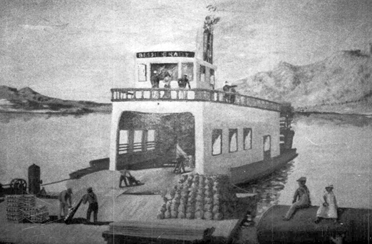
Bessie Brady


Molly Stevens
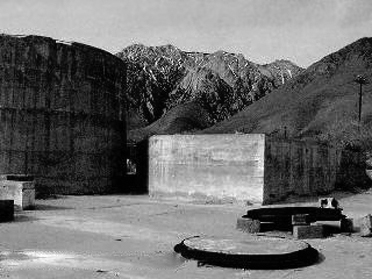
Cartago
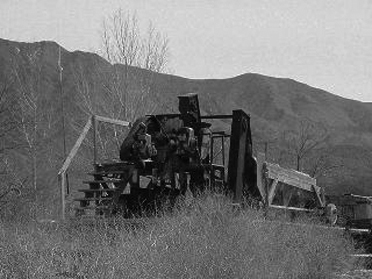
Keeler
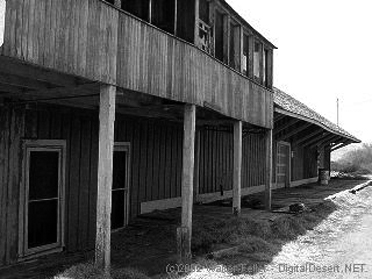
Keeler
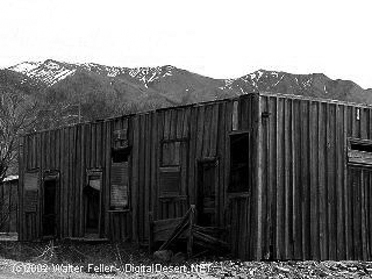
Keeler

Swansea

Swansea
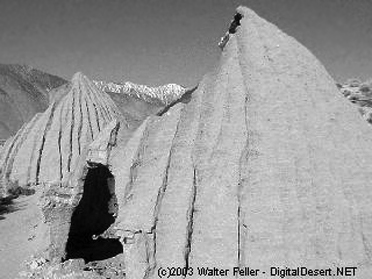 Cottonwood kilns
Cottonwood kilns